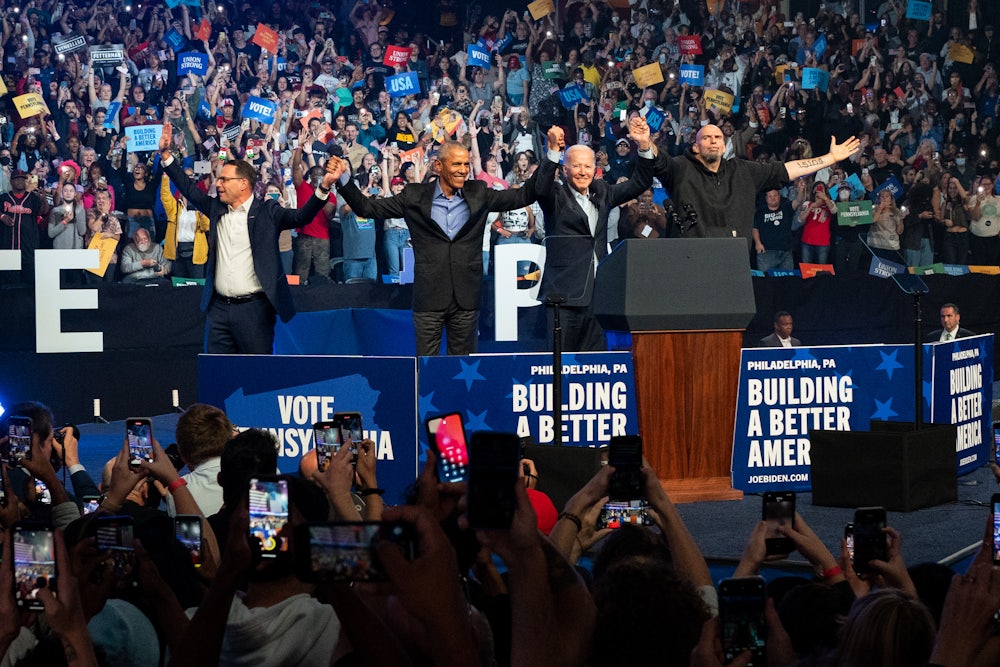On a crisp Saturday morning at the University of Pittsburgh, just a few days before the 2022 midterms, former President Obama stood on a stage interlocking hands with Pennsylvania Lieutenant Governor John Fetterman. Cheers had erupted from the crowd throughout Obama’s speech as he ticked off his 2022 stump lines on the country’s overly partisan atmosphere (“This habit we have of demonizing political opponents, of saying crazy stuff; it creates a dangerous climate”), crime (“Violent crime has gone up, but it went up over the last seven years, not just the last two”), and the economy (“They want to gut Social Security, they want to gut Medicare, they want to give rich folks and big corporations more tax cuts”).
“I am here to ask you to vote,” Obama said at the end of his speech, allowing a round of cheers before continuing, “for your next members of Congress. Chris Deluzio and Summer Lee—vote for them! For your next governor, [gubernatorial candidate Josh] Shapiro, and for your next great senator, John Fetterman.”
Later on that day, Obama and Fetterman were in Philadelphia, another safely blue-leaning part of the state, for a rally with President Joe Biden. Pennsylvania remains a battleground state. Driving from one side of the state to the other, it’s easy to find Trump signs set right next to signs for Doug Mastriano, the Christian nationalist candidate nominated by Pennsylvania Republicans to be governor.
It’s telling that Obama, Fetterman, and Biden were appearing where they were. The appearances were part of a larger pattern the most high-profile Democratic surrogates have been following in the final days of the 2022 midterm elections: Rally the base. For much of this election cycle, Democrats have had to grapple with not only the predictable hurdles of current events—inflation, the Dobbs ruling, and the war in Ukraine—but also an enthusiasm deficit on their side in the face of rabid enthusiasm for Republicans.
That was somewhat to be expected. These midterms were all but foreordained as a certain bloodbath for Democrats or, if you prefer the standard talking points of basically any Republican operative in the United States, a “red wave” year for Republicans. But here, on the eve of the election, there’s still the remote possibility that the election might not be a complete shellacking. Polling shows tight races in all of the key battleground Senate races, even though indicators strongly favor Republicans taking back the House of Representatives by some comfortable margins. Democratic enthusiasm has been on the rise in the past few days as well.
“Our vote’s coming in. The question is, how big is their vote going to be?” veteran Democratic strategist Simon Rosenberg said.
Overall, the indicators are that Republicans will have a pretty good night on Tuesday. But there’s a strong possibility that when the dust settles, both parties might be staring into a mixed bag. Republicans could retake the governor’s mansion in Nevada while narrowly failing to oust Democratic Senator Catherine Cortez Masto. Similarly, conservative Republican Kari Lake is the heavy favorite to become the next governor of Arizona, but there’s plenty of reason for Democrats to be optimistic the Senate race will narrowly go to incumbent Senator Mark Kelly.
These are the fruits of a topsy-turvy election cycle where Democrats enjoyed some surprise highs underneath the dark specter of a drubbing, as well as some legislative struggles—remember how the entire Democratic Party fell out over the Build Back Better Act?
“The progressive wing of the Democratic Party in particular—but I think Democratic activists,” said Joseph Geevarghese, executive director of the Bernie Sanders–aligned Our Revolution outside group, “were really disgruntled and dismayed that Democrats held the trifecta—they had the House, they had the Senate, and they had the White House; we had a president that was promising a bold agenda—and they, the president and others, were stymied by [Senator Joe] Manchin and [Senator Kyrsten] Sinema. That was incredibly demoralizing. It’s not just the other side. It’s not just the Republicans aligned against us; it’s the enemy within our own party, and that was incredibly demoralizing for our base.”
But even in red-leaning states like Georgia, the only undeniable indicator for the two most attended races is that turnout will be high. Georgia has competitive Senate and gubernatorial contests. Tuesday will mark the first election since the passage of a restrictive voting law last year, passed in the wake of President Joe Biden’s narrow victory in the state. Despite the barriers erected by this law, such as limiting the period to request and send absentee ballots, Georgia has seen record early voting turnout. As of Sunday, 2.5 million people had voted early—nearly 500,000 more than voted early in 2018.
Despite predictions of a Republican wave, some Democrats in the state insist that their voters are motivated to turn out. “When you look under the hood of these early vote numbers, there’s a lot of signs of very strong Democratic enthusiasm,” said Lauren Groh-Wargo, the campaign manager for Democratic candidate Stacey Abrams, in a press call on Monday, pointing to high turnout among Black voters and in counties that have often supported Democrats. Abrams is engaged in a rematch with GOP Governor Brian Kemp, to whom she narrowly lost in 2018. Meanwhile, Senator Raphael Warnock is locked in a difficult reelection fight, facing a challenge from Republican Herschel Walker.
But there is still a sense of fatigue among voters, and particularly younger Georgians. “The candidates Stacey Abrams and Raphael Warnock are very motivating to young people, and very trustworthy, but for many young people, they may not feel like enough,” said Alex Ames, a 20-year-old college student in Atlanta and the organizing director for Georgia Youth Justice Coalition. “It may not feel like this election has provided enough for young people to feel like, ‘Yeah, if I show up, my life is going to change.’ I don’t want to call that apathy, as much as just a feeling that our political system isn’t meeting the moment as a whole for what young people deserve.”
Tembi Hove, a member of the union Unite Here Local 23 in Atlanta, has been canvassing Democratic-leaning voters in Columbus, Georgia, ahead of the election. Hove said that many of the potential voters she speaks to understand the stakes of the election, but others are disillusioned and frustrated. “There’s still a group of younger folks, and it seems to be more of the younger Black men, who feel that voting doesn’t matter, it doesn’t count; ‘What’s the purpose? It’s not going to make a difference,’” she said.
But Hove also said that she believed some people were waiting until Election Day to cast their ballot and that she expected a high turnout in Georgia on Tuesday. “The types of neighborhoods we’re going in, these are the people who need those things that Stacey Abrams and Raphael Warnock are promising to do for us, like increasing teacher pay, like affordable health care, affordable prescriptions, cleaning up our neighborhoods, taking care of gun violence,” Hove said.
Whatever happens on election night, it’s safe to predict that some strategists, candidates, and observers will say the outcome was always clear. Sorry, but it wasn’t.
“A lot of these races are going to be incredibly tight, and I think it’s really going to come down to ground game and which side has the best get-out-the-vote operation on the ground,” Geevarghese said. “Whether it’s organizing through churches, at the precinct level, I really do think that’s going to be key because there’s persuasive messaging on both sides. But foundationally, at the headwinds facing Democrats—inflation, rising gas prices, that plays against Democrats. But I think there’s enough Democratic voters, if they were motivated to vote, yeah, I think we can hold our own.”










